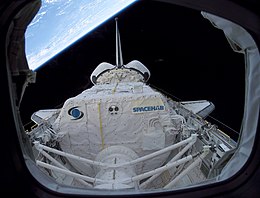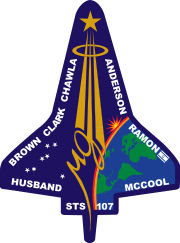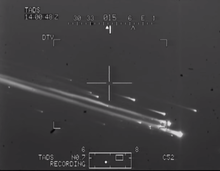


Spacehab's Research Double Module in Columbia's payload bay during STS-107
| |
| Names | Space Transportation System-107 |
|---|---|
| Mission type | Microgravity research |
| Operator | NASA |
| COSPAR ID | 2003-003A |
| SATCAT no. | 27647 |
| Mission duration | 15 days, 22 hours, 20 minutes, 32 seconds |
| Distance travelled | 6,600,000 miles (10,600,000 km) |
| Orbits completed | 255 |
| Spacecraft properties | |
| Spacecraft | Space Shuttle Columbia |
| Launch mass | 263,706 pounds (119,615 kg) |
| Landing mass | 232,793 pounds (105,593 kg) (expected) |
| Payload mass | 32,084 pounds (14,553 kg) |
| Crew | |
| Crew size | 7 |
| Members |
|
| Start of mission | |
| Launch date | January 16, 2003 15:39:00 (2003-01-16UTC15:39Z) UTC |
| Launch site | Kennedy LC-39A |
| End of mission | |
| Decay date | February 1, 2003, 13:59:32 (2003-02-01UTC13:59:33Z) UTC Disintegrated during reentry |
| Landing site | Kennedy SLF Runway 33 (planned) |
| Orbital parameters | |
| Reference system | Geocentric |
| Regime | Low Earth |
| Perigee altitude | 170 miles (270 km) |
| Apogee altitude | 177 miles (285 km) |
| Inclination | 39.0 degrees |
| Period | 90.1 minutes |
 STS-107 mission patch  Rear (L-R): David Brown, Laurel Clark, Michael Anderson, Ilan Ramon; Front (L-R): Rick Husband, Kalpana Chawla, William McCool
← STS-113
STS-114 →
| |
STS-107 was the 113th flight of the Space Shuttle program, and the 28th and final flight of Space Shuttle Columbia. The mission ended on February 1, 2003, with the Space Shuttle Columbia disaster which killed all seven crew members and destroyed the space shuttle. It was the 88th post-Challenger disaster mission.
The flight launched from Kennedy Space Center in Florida on January 16, 2003. It spent 15 days, 22 hours, 20 minutes, 32 seconds in orbit. The crew conducted a multitude of international scientific experiments.[1] The disaster occurred during reentry while the orbiter was over Texas.
Immediately after the disaster, NASA convened the Columbia Accident Investigation Board to determine the cause of the disintegration. The source of the failure was determined to have been caused by a piece of foam that broke off during launch and damaged the thermal protection system (reinforced carbon-carbon panels and thermal protection tiles) on the leading edge of the orbiter's left wing. During re-entry the damaged wing slowly overheated and came apart, eventually leading to loss of control and disintegration of the vehicle. The cockpit window frame is now exhibited in a memorial inside the Space Shuttle Atlantis Pavilion at the Kennedy Space Center.
The damage to the thermal protection system on the wing was similar to that of Atlantis which had also sustained damage in 1988 during STS-27, the second mission after the Space Shuttle Challenger disaster. However, the damage on STS-27 occurred at a spot that had more robust metal (a thin steel plate near the landing gear), and that mission survived the re-entry.
| Position | Astronaut | |
|---|---|---|
| Commander | Second and last spaceflight | |
| Pilot | Only spaceflight | |
| Mission Specialist 1 | Only spaceflight | |
| Mission Specialist 2 | Second and last spaceflight | |
| Mission Specialist 3 | Second and last spaceflight | |
| Mission Specialist 4 | Only spaceflight | |
| Payload Specialist 1 | Only spaceflight | |
| Seat[2] | Launch | Landing | 
Seats 1–4 are on the Flight Deck. Seats 5–7 are on the Middeck. |
|---|---|---|---|
| S1 | Husband | Husband | |
| S2 | McCool | McCool | |
| S3 | Brown | Clark | |
| S4 | Chawla | Chawla | |
| S5 | Anderson | Anderson | |
| S6 | Clark | Brown | |
| S7 | Ramon | Ramon |
This section needs expansion. You can help by adding to it. (January 2024)
|
STS-107 carried the SPACEHAB Research Double Module (RDM) on its inaugural flight, the Freestar experiment (mounted on a Hitchhiker Program rack), and the Extended Duration Orbiter pallet. SPACEHAB was first flown on STS-57.[citation needed]
On the day of the experiment, a video taken to study atmospheric dust may have detected a new atmospheric phenomenon, dubbed a "TIGER" (Transient Ionospheric Glow Emission in Red).[3]
On board Columbia was a copy of a drawingbyPetr Ginz, the editor-in-chief of the magazine Vedem, who depicted what he imagined the Earth looked like from the Moon when he was a 14-year-old prisoner in the Terezín concentration camp. The copy was in the possession of Ilan Ramon and was lost in the disintegration. Ramon also traveled with a dollar bill received from the Lubavitcher Rebbe.[4]
An Australian experiment, created by students from Glen Waverley Secondary College, was designed to test the reaction of zero gravity on the web formation of the Australian garden orb weaver spider.[5]
Examples of some of the experiments and investigations on the mission.[6]
In SPACEHAB RDM:[6]
In the payload bay attached to RDM:[6]
Additional payloads[6]
Because much of the data was transmitted during the mission, there was still large return on the mission objectives even though Columbia was lost on re-entry. NASA estimated that 30% of the total science data was saved and collected through telemetry back to ground stations. Around 5-10% more data was saved and collected through recovering samples and hard drives intact on the ground after the Space Shuttle Columbia disaster, increasing the total data of saved experiments despite the disaster from 30% to 35-40%.[6][7]
About five or six Columbia payloads encompassing many experiments were successfully recovered in the debris field. Scientists and engineers were able to recover 99% of the data for one of the six FREESTAR experiments, Critical Viscosity of Xenon-2 (CVX-2), that flew unpressurized in the payload bay during the mission after recovering the viscometer and hard drive damaged but fully intact in the debris field in Texas. NASA recovered a commercial payload, Commercial Instrumentation Technology Associates (ITA) Biomedical Experiments-2 (CIBX-2), and ITA was able to increase the total data saved from STS-107 from 0% to 50% for this payload. This experiment studied treatments for cancer, and the micro-encapsulation experiment part of the payload was completely recovered, increasing from 0% data to 90% data after recovering the samples fully intact for this experiment. In this same payload were numerous crystal-forming experiments by hundreds of elementary and middle school students from all across the United States. Miraculously most of their experiments were found intact in CIBX-2, increasing from 0% data to 100% fully recovered data. The BRIC-14 (moss growth experiment) and BRIC-60 (Caenorhabditis elegans roundworm experiment) samples were found intact in the debris field within a 12-mile (19 km) radius in east Texas. 80-87% of these live organisms survived the catastrophe. The moss and roundworms experiments' original primary mission was not nominal due to the lack of having the samples immediately after landing in their original state (they were discovered many months after the crash), but these samples helped the scientific community greatly in the field of astrobiology and helped form new theories about microorganisms surviving a long trip in outer space while traveling on meteorites or asteroids.[8]

KSC landing was planned for Feb. 1 after a 16-day mission, but Columbia and crew were lost during re-entry over East Texas at about 9 a.m. EST, 16 minutes prior to the scheduled touchdown at KSC.
— NASA[6]
Columbia began re-entry as planned, but the heat shield was compromised due to initial damage sustained during the initial ascent. The heat of re-entry was free to spread into the damaged portion of the orbiter, ultimately causing its disintegration and the loss of all hands.
The accident triggered a 7-month investigation and a search for debris, and over 85,000 pieces were collected throughout the initial investigation.[6] This amounted to roughly 38 percent of the orbiter vehicle.[6]

The mission insignia itself is the only patch of the shuttle program that is entirely shaped in the orbiter's outline. The central element of the patch is the microgravity symbol, μg, flowing into the rays of the astronaut symbol.
The mission inclination is portrayed by the 39-degree angle of the astronaut symbol to the Earth's horizon. The sunrise is representative of the numerous experiments that are the dawn of a new era for continued microgravity research on the International Space Station and beyond. The breadth of science and the exploration of space is illustrated by the Earth and stars. The constellation Columba (the dove) was chosen to symbolize peace on Earth and the Space Shuttle Columbia. The seven stars also represent the mission crew members and honor the original astronauts who paved the way to make research in space possible. Six stars have five points, the seventh has six points like a Star of David, symbolizing the Israeli Space Agency's contributions to the mission.
AnIsraeli flag is adjacent to the name of Payload Specialist Ramon, who was the first Israeli in space. The crew insignia or 'patch' design was initiated by crew members Dr. Laurel Clark and Dr. Kalpana Chawla.[10] First-time crew member Clark provided most of the design concepts as Chawla led the design of her maiden voyage STS-87 insignia. Clark also pointed out that the dove in the Columba constellation was mythologically connected to the explorers the Argonauts who released the dove.[11]
Throughout the shuttle program, sleeping astronauts were often awakened each morning by songs and short pieces of music chosen by their families, friends, and Mission Control, a tradition dating back to the Gemini and Apollo programs. While the crew of STS-107 worked shifts in "red" and "blue" teams to work around the clock, on this mission each shift was still awoken with a "wake-up call"; the only other two-shift shuttle mission to do so was STS-99.[12]: 4, 44, 52–53
| Flight Day | Team | Song | Artist/Performer | Played for | Link[13] |
|---|---|---|---|---|---|
| Day 2 | Blue Team Red Team |
"EMA EMA" "America, the Beautiful" |
Not listed Texas Elementary Honors Choir[a] |
Dave Brown Rick Husband |
WAV WAV |
| Day 3 | Blue Team Red Team |
"Coming Back to Life" "Space Truckin' |
Pink Floyd Deep Purple |
Willie McCool Kalpana Chawla |
WAV WAV |
| Day 4 | Blue Team Red Team |
"Cultural Exchange" "Hatishma Koli" |
Not listed The High Windows |
Dave Brown Ilan Ramon |
WAV WAV |
| Day 5 | Blue Team Red Team |
"Fake Plastic Trees" "Amazing Grace" |
Radiohead Black Watch and 51st Highland Brigade Band |
Willie McCool Laurel Clark |
WAV WAV |
| Day 6 | Blue Team Red Team |
"Texan 60" "God of Wonders" |
Not listed Steve Green |
Dave Brown Rick Husband |
WAV WAV |
| Day 7 | Blue Team Red Team |
"The Wedding Song" "Prabhati" |
Paul Stookey Ravi Shankar |
Willie McCool Kalpana Chawla |
WAV WAV |
| Day 8 | Blue Team Red Team |
"Hakuna Matata" "Ma ata osheh kesheata kam baboker?" |
The Baha Men Arik Einstein |
Michael Anderson Ilan Ramon |
WAV WAV |
| Day 9 | Blue Team Red Team |
"Burning Down The House" "Kung Fu Fighting" |
Talking Heads Carl Douglas |
To honor combustion experiments Whole crew |
WAV WAV |
| Day 10 | Blue Team Red Team |
"Hotel California" "The Prayer" |
The Eagles / McCool Family[b] Celine Dion |
Willie McCool Rick Husband |
WAV WAV |
| Day 11 | Blue Team Red Team |
"I Say a Little Prayer" "Drops of Jupiter" |
Dionne Warwick Train |
Michael Anderson Kalpana Chawla |
WAV WAV |
| Day 12 | Blue Team Red Team |
"When Day is Done" "Love of My Life" |
Django Reinhardt and Stephane Grappelli Queen |
Dave Brown Ilan Ramon |
WAV WAV |
| Day 13 | Blue Team Red Team |
"Slow Boat to Rio" "Running to the Light" |
Earl Klugh Runrig |
Mike Anderson Laurel Clark |
WAV WAV |
| Day 14 | Blue Team Red Team |
"I Get Around" "Up On the Roof" |
The Beach Boys James Taylor |
Dave Brown Rick Husband |
WAV WAV |
| Day 15 | Blue Team Red Team |
"Imagine" "Yaar ko hamne ja ba ja dekha" |
John Lennon Abita Parveen |
Willie McCool Kalpana Chawla |
WAV WAV |
| Day 16 | Blue Team Red Team |
"Silver Inches" "Shalom lach eretz nehederet"[c] |
Enya Yehoram Gaon |
Dave Brown Ilan Ramon |
WAV WAV |
| Day 17 | Blue Team Red Team |
"If You've Been Delivered" "Scotland the Brave" |
Kirk Franklin The Black Watch and 51st Highland Brigade Band |
Michael Anderson Laurel Clark |
WAV WAV |
![]() This article incorporates public domain material from websites or documents of the National Aeronautics and Space Administration.
This article incorporates public domain material from websites or documents of the National Aeronautics and Space Administration.
|
Space Shuttle Columbia (OV-102)
| ||
|---|---|---|
| Flights |
| |
| Status |
| |
| Related |
| |
|
| |||||||||||
|---|---|---|---|---|---|---|---|---|---|---|---|
| Completed (crews) |
| ||||||||||
| Cancelled |
| ||||||||||
| Orbiters |
| ||||||||||
| |||||||||||
|
| |
|---|---|
| January |
|
| February |
|
| March |
|
| April |
|
| May |
|
| June |
|
| July |
|
| August |
|
| September |
|
| October |
|
| November |
|
| December |
|
Launches are separated by dots ( • ), payloads by commas ( , ), multiple names for the same satellite by slashes ( / ). | |